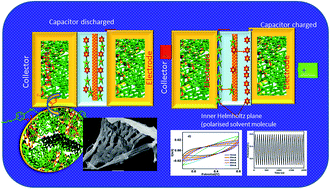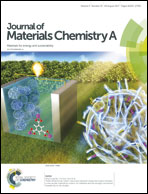Self-assembled polyaniline nanowires stippled graphene-3-pentadecylphenyl phosphate hybrid nanocomposite based green sustainable electrodes for supercapacitors†
Abstract
Self-assembled polyaniline nanowires stippled graphene nanocomposites (PGPCs) were prepared by in situ polymerisation of aniline in the presence of 3-pentadecylphenyl phosphate (3-PDPP) modified graphene sheets. 3-PDPP is an amphiphilic dopant derived from cardanol obtained as a waste byproduct from the cashew industry, which serves a multifunctional role as a template, a surfactant, and a dopant and facilitates the self-assembly process during the formation of the supramolecular organisation of the PGPC nanocomposite. The formed PGPCs were characterised by Fourier transform infrared spectroscopy (FTIR), X-ray diffraction (XRD), scanning electron microscopy (SEM), transmission electron microscopy (TEM), atomic force microscopy (AFM), pore volume, Brunauer–Emmett–Teller (BET) surface area, thermal gravimetric analysis (TGA), electrical conductivity (2.32 S cm−1) and electrochemical stability. Further symmetrical supercapacitors were fabricated with the configurations (indium tin oxide (ITO)–PGPC/Na2SO4/PGPC–ITO) and (ITO–PGPC/polyvinyl alcohol (PVA)–H3PO4/PGPC–ITO) and measured optimal specific capacitance (812.55 F g−1 using PVA–H3PO4 and 791.26 F g−1 using Na2SO4) and energy density (109.89 Wh kg−1 using Na2SO4 and 112.85 Wh kg−1 using PVA–H3PO4) and cycling stability (>2000). All these interesting results suggest its suitability as a sustainable efficient electrode for the fabrication of supercapacitors.


 Please wait while we load your content...
Please wait while we load your content...